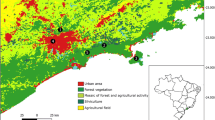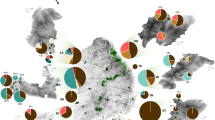Abstract
In polygynous mammals, males are usually responsible for gene flow while females are predominantly philopatric. However, there is evidence that in a few mammalian species female offspring may disperse to avoid breeding with their father when male tenure exceeds female age at maturity. We investigated offspring dispersal and local population structure in the Neotropical bat Lophostoma silvicolum. The mating system of this species is resource defense polygyny, with the resource being active termite nests, excavated by single males, which are then joined by females. We combined field observations of 14 harems during 3 years and data about the genetic structure within and between these groups, calculated with one mitochondrial locus and nine nuclear microsatellite loci. The results show that both male and female offspring disperse before maturity. In addition, we estimated life span of excavated termite nests and the duration they were occupied by the same male. Our findings suggest that long male tenure of up to 30 months is indeed a likely cause for the observed dispersal by female offspring that can reach maturity at a low age of 6 months. We suggest that dispersal by offspring of both sexes may occur quite frequently in polygynous tropical bats and thus generally may be more common in mammals than previously assumed.


Similar content being viewed by others
References
Banks SC, Skerratt LF, Taylor AC (2002) Female dispersal and relatedness structure in common wombats (Vombatus ursinus). J Zool 256:389–399
Barclay RMR, Ulmer J, MacKenzee CJA, Thompson MS, Olson L, McCool J, Cropey EE, Poll G (2004) Variation in the reproductive rate of bats. Can J Zool 82:688–693
Belwood JJ (1988) The influence of bat predation on calling behaviour in Neotropical forest katydids (Insecta: Orthoptera: Tettigoniidae). University of Florida, Gainesville
Bockholdt C (1998) Hangplatzwahl, Aktivitätsrhythmik und Aktionsraum der neotropischen Fledermaus Tonatia silvicola (D’Orbigny, 1836). Fakultät für Biologie. Universität Freiburg, Freiburg, pp 94
Bradley BJ, Doran-Sheehy DM, Lukas D, Boesch C, Vigilant L (2004) Dispersed male networks in western gorillas. Curr Biol 14:510–513
Brooke AP (1997) Social organization and foraging behaviour of the fishing bat, Noctilio leporinus (Chiroptera:Noctilionidae). Ethology 103:421–436
Burland TM, Worthington-Wilmer JW (2001) Seeing in the dark: molecular approaches to the study of bat populations. Biol Rev 76:389–409
Burland TM, Barratt EM, Beaumont MA, Racey PA (1999) Population genetic structure and gene flow in a gleaning bat, Plecotus auritus. Proc R Soc Lond B 266:975–980
Burland TM, Barratt EM, Nichols RA, Racey PA (2001) Mating patterns, relatedness and the basis of natal philopatry in the brown long-eared bat, Plecotus auritus. Mol Ecol 10:1309–1321
Castella V, Ruedi M, Excoffier L (2001) Contrasted patterns of mitochondrial and nuclear structure among nursery colonies of the bat Myotis myotis. J Evol Biol 14:708–720
Clarke AL, Saether B-E, Roskraft E (1997) Sex biases in avain dispersal: a reappraisal. Oikos 79:429–438
Clifford SL, Anthony NM, Bawe-Johnson M, Abernethy KA, Tutin CEG, White LJT, Bermejo M, Goldsmith ML, McFarland K, Jeffery KJ, Bruford MW, Wickings EJ (2004) Mitochondrial DNA phylogeography of western lowland gorillas (Gorilla gorilla gorilla). Mol Ecol 13:1551–1565
Clobert J, Danchin E, Dhondt AA, Nichols JD (2001) Dispersal. Oxford University Press, Oxford, UK
Clutton-Brock TH (1989a) Female transfer and inbreeding avoidance in social mammals. Nature 337:70–72
Clutton-Brock TH (1989b) Mammalian mating systems. Proc R Soc Lond B 236:339–372
Dechmann DKN, Garbely E, Kerth G, Garner TWJ (2002) Highly polymorphic microsatellites for the study of the round-eared bat, Tonatia silvicola (d’Orbigny). Conservation Genetics 3:455–458
Dechmann DKN, Kalko EKV, Kerth G (2004) Ecology of an exceptional roost: energetic benefits could explain why the bat Lophostoma silvicolum roosts in active termite nests. Evol Ecol Res 6:1037–1050
Dechmann DKN, Kalko EKV, König B, Kerth G (2005) Mating system of a Neotropical roost making bat: the white-throated, round-eared bat, Lophostoma silvicolum (Chiroptera: Phyllostomidae). Behav Ecol Sociobiol 58:316–325
Dobson FS (1982) Competition for mates and predominant juvenile male dispersal in mammals. Anim Behav 30:1183–1192
Favre L, Balloux F, Goudet J, Perrin N (1997) Female-biased dispersal in the monogamous mammal Crocidura russula: Evidence from field data and microsatellite patterns. Proc R Soc Lond B Biol Sci 264:127–132
Goudet J, Raymond M, de Meeüs T, Rousset F (1996) Testing differentiation in diploid populations. Genetics 144:1933–1940
Greenwood PJ (1980) Mating systems, philopatry and dispersal in birds and mammals. Anim Behav 28:1140–1162
Hammond RL, Lawson Handley LJ, Wineey BJ, Bruford MW, Perrin N (2006) Genetic evidence for female-biased dispersal and gene flow in a polygynous primate. Proc R Soc B 273:479–484
Heckel G, Von Helversen O (2003) Genetic mating system and the significance of harem associations in the bat Saccopteryx bilineata. Mol Ecol 12:219–227
Heckel G, Voigt CC, Mayer F, Von Helversen O (1999) Extra-harem paternity in the white-lined bat Saccopteryx bilineata (Emballonuridae). Behaviour 136:1173–1185
Kalko EKV, Handley CO, Handley D (1996) Organization, diversity, and long-term dynamics of a Neotropical bat community. In: Cody ML, Smallwood JA (eds) Long-term studies of vertebrate communities. Academic Press, San Diego, pp 503–553
Kalko EKV, Friemel D, Handley CO, Schnitzler HU (1999) Roosting and foraging behavior of two Neotropical gleaning bats, Tonatia silvicola and Trachops cirrhosus (Phyllostomidae). Biotropica 31:344–353
Kalko EKV, Ueberschaer K, Dechmann DKN (2006) Roost structure, modification, and availability in the white-throated, round-eared bat, Lophostoma silvicolum (Phyllostomidae) living in active termite nests. Biotropica 38:1–7
Kerth G, König B (1996) Transponder and an infrared-videocamera as methods used in a field study on the social behaviour of Bechstein’s Bat (Myotis bechsteinii). Myotis 34:27–34
Kerth G, König B (1999) Fission, fusion and nonrandom associations in female Bechstein’s bats (Myotis bechsteinii). Behaviour 136:1187–1202
Kerth G, Morf L (2004) Behavioural and genetic data suggest that Bechstein’s bats predominantly mate outside the breeding habitat. Ethology 110:987–999
Kerth G, Mayer F, König B (2000) Mitochondrial DNA (mtDNA) reveals that female Bechstein’s bats live in closed societies. Mol Ecol 9:793–800
Kerth G, Mayer F, Petit E (2002a) Extreme sex-biased dispersal in the communally breeding, nonmigratory Bechstein’s bat (Myotis bechsteinii). Mol Ecol 11:1491–1498
Kerth G, Safi K, Konig B (2002b) Mean colony relatedness is a poor predictor of colony structure and female philopatry in the communally breeding Bechstein’s bat (Myotis bechsteinii). Behav Ecol Sociobiol 52:203–210
Kerth G, Kiefer A, Trappmann C, Weishaar M (2003) High gene diversity at swarming sites suggest hot spots for gene flow in the endangered Bechstein’s bat. Conservation Genetics 4:491–499
Koenig WD, Van Vuren D, Hooge PN (1996) Detectability, philopatry, and the distribution of dispersal distances in vertebrates. Trends Ecol Evol 11:514–517
Lang AB, Kalko EKV, Römer H, Bockholdt C, Dechmann DKN (2006) Activity levels of bats and katydids in relation to the lunar cycle. Oecologia 146:659–666
Marshall TC, Slate J, Kruuk LEB, Pemberton JM (1998) Statistical confidence for likelihood-based paternity inference in natural populations. Mol Ecol 7:639–655
McCracken GF, Bradbury JW (1981) Social organization and kinship in the polygynous bat Phyllostomus hastatus. Behav Ecol Sociobiol 8:11–34
McCracken GF, Wilkinson GS (2000) Bat mating systems. In: Crichton EG, Krutzsch PH (eds) Reproductive biology of bats. Academic Press, London, pp 321–357
Moore J, Ali R (1984) Are dispersal and inbreeding avoidance related. Anim Behav 32:94–112
Moran MD (2003) Arguments for rejecting the sequential Bonferroni in ecological studies. Oikos 100:403–405
Müllenbach R, Lagoda PJL, Welter C (1989) An efficient salt chloroform extraction method of DNA from blood and tissues. Trends Genet 5:391
Nei M (1987) Molecular evolutionary genetics. Columbia University Press, New York
Ortega J, Maldonado JE, Arita HT, Wilkinson GS, Fleischer RC (2002) Characterization of microsatellite loci in the Jamaican fruit-eating bat Artibeus jamaicensis and cross-species amplification. Mol Ecol Notes 2:462–464
Ortega J, Maldonado JE, Wilkinson GS, Arita HT, Fleischer RC (2003) Male dominance, paternity, and relatedness in the Jamaican fruit-eating bat (Artibeus jamaicensis). Mol Ecol 12:2409–2415
Perrin N, Mazalov V (1999) Dispersal and inbreeding avoidance. Am Nat 154:282–292
Petit E, Balloux F, Goudet J (2001) Sex-biased dispersal in a migratory bat: a characterization using sex-specific demographic parameters. Evolution 55:635–640
Queller DC, Goodnight KF (1989) Estimating relatedness using genetic-markers. Evolution 43:258–275
Raymond M, Rousset F (1995) An exact test for population differentiation. Evolution 49:1280–1283
Reid FA (1997) A field guide to the mammals of Central America and Southeast Mexico. Oxford University Press, New York, Oxford
Rossiter SJ, Jones G, Ransome RD, Barratt EM (2000a) Genetic variation and population structure in the endangered greater horseshoe bat Rhinolophus ferrumequinum. Mol Ecol 9:1131–1135
Rossiter SJ, Jones G, Ransome RD, Barratt EM (2000b) Parentage, reproductive success and breeding behaviour in the greater horseshoe bat (Rhinolophus ferrumequinum). Proc R Soc Lond, B Biol Sci 267:545–551
Rossiter SJ, Jones G, Ransome RD, Barratt EM (2002) Relatedness structure and kin-biased foraging in the greater horseshoe bat (Rhinolophus ferrumequinum). Behav Ecol Sociobiol 51:510–518
Rossiter SJ, Ransome RD, Faulkes CG, Le Comber SC, Jones G (2005) Mate fidelity and intra-lineage polygyny in greater horseshoe bats. Nature 437:408–411
Ruckstuhl KE, Neuhaus P (2000) Sexual segregation in ungulates: a new approach. Behaviour 137:361–377
Schneider S, Roessli D, Escoffier L (2000) Arlequin ver. 2.000: a software for population genetics data analysis. Genetics and Biometry Laboratory, University of Geneva, Switzerland
Sedgeley JA, O’Donnell CFJ (1999) Roost selection by the long-tailed bat, Chalinolobus tuberculatus, in temperate New Zealand rainforest and its implications for the conservation of bats in managed forests. Biol Conserv 88:261–276
Seielstad MT, Minch E, Cavalli-Sforza LL (1998) Genetic evidence for a higher female migration rate in humans. Nat Genet 20:278–280
Shuster SM, Wade MJ (2003) Mating systems and strategies. Princeton Press, Princeton
Storz JF, Bhat HR, Kunz TH (2000) Social structure of a polygynous tent-making bat, Cynopterus sphinx (Megachiroptera). J Zool 251:151–165
Storz JF, Bhat HR, Kunz TH (2001) Genetic consequences of polygyny and social structure in an Indian fruit bat, Cynopterus sphinx. I. Inbreeding, outbreeding, and population subdivision. Evolution 55:1215–1223
Vonhof MJ, Whitehead H, Fenton MB (2004) Analysis of Spix’s disc-winged bat association patterns and roosting home ranges reveal a novel social structure among bats. Anim Behav 68:507–521
Weir BS, Cockerham CC (1984) Estimating F-statistics for the analysis of population structure. Evolution 38:1358–1370
Wilkinson GS (1985) The social-organization of the common vampire bat 2. Mating system, genetic-structure, and relatedness. Behav Ecol Sociobiol 17:123–134
Wilkinson GS, Chapman AM (1991) Length and sequence variation in evening bat D-Loop MtDNA. Genetics 128:607–617
Wilkinson GS, Mayer F, Kerth G, Petri B (1997) Evolution of repeated sequence arrays in the D.loop region of bat mitochondrial DNA. Genetics 146:1035–1048
Williams DA, Rabenold KN (2005) Male-biased dispersal, female philopatry, and routes to fitness in a social corvid. J Anim Ecol 74:150–159
Worthington-Wilmer J, Hall L, Barratt E, Moritz C (1999) Genetic structure and male-mediated gene flow in the ghost bat (Macroderma gigas). Evolution 53:1582–1591
Acknowledgements
The Roche Research Foundation and the ZUNIV-Fonds zur Förderung des Akademischen Nachwuchses (FAN) financed Dina Dechmann during this study. The Julius–Klaus–Stiftung (Zürich) and the Brachet Foundation (Belgium) financed the genetic analyses, which were carried out with much help from J. Garbely. We want to thank the Smithsonian Tropical Research Institute (STRI) and the National Authority for the Environment (ANAM) for research permits and the staff of Barro Colorado Island, especially the game wardens for logistical support. The following people helped with fieldwork, development of equipment and/or with data analysis: A. Beck, M. Demir, S. Heucke, M. Kalka, R. Kays, J. Mandel, F. Neuhäuser-Wespy, K. Safi-Widmer, A. Schulz, M. Weinbeer, S. Wetterich, and especially K. Safi, A. Lang, S. Spehn, and C. Weise. We also thank M. Brigham, F. Mayer, A. McElligott, E. Petit, K. Safi, S. Spehn, and C. Voigt for valuable comments about the manuscript and B. König for her continuous support.
Author information
Authors and Affiliations
Corresponding author
Additional information
Communicated by G. Wilkinson
Rights and permissions
About this article
Cite this article
Dechmann, D.K.N., Kalko, E.K.V. & Kerth, G. All-offspring dispersal in a tropical mammal with resource defense polygyny. Behav Ecol Sociobiol 61, 1219–1228 (2007). https://doi.org/10.1007/s00265-007-0352-z
Received:
Revised:
Accepted:
Published:
Issue Date:
DOI: https://doi.org/10.1007/s00265-007-0352-z




